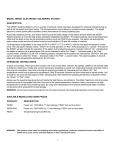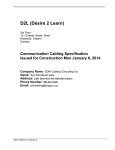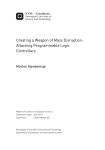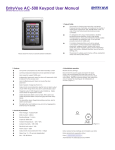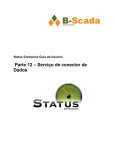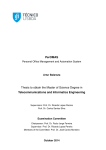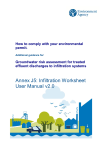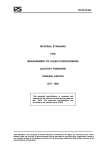Download Dia 1 - LonMark International
Transcript
Security Hardening in Building Networks Challenges in making Building Networks secure from inside and outside threads and how we can manage this LONMARK – The Next Generation Presenter • Hans-Jörg Schweinzer – LOYTEC Founding Partner and CEO – Marketing, Business Development, Sales • Involvement – Fieldbus and Internet technology for more than 25 years – Active in CEN TC247, ISO TC205, CENELEC TC205 Overview • • • • • • Motivation Security Threats Network Security Secure Protocols System Hardening Secure Mode Motivation • Internal comm – IP-based protocols – IT components – Controller to controller – Controller to panels • External comm – Mobile devices – Web Access – BMS Access Threats in The Press • Stuxnet on Iranian Centrifuge – Worm infecting industrial controller equipment – IEEE Spectrum – The Real Story of Stuxnet • Marvel of connectivity illustrates new cyber risks – Hackers focus on Internet-connected control systems – July 12, 2012 • Botnet captures routers – Malware on Routers for spying on traffic (report passwords) – c’t 21, 2013 Threats: Clear-Text • Clear-Text – Read user/password (break-in) – Record usage behavior (burglars) Threats: Replay • Replay recorded requests Web Service CEA-852 BACnet/IP Threats: Man-In-The-Middle • Secure Traffic • Man-In-The-Middle Clear Text AP, Router Page 8 Threats: Exploits • Denial of service – Keep device from productive function – Use open ports – Exploit vulnerability (e.g. reboot) Security • Communication – Integrity – Confidentiality – Authenticity – Non-Repudiation Chuck • System – Strong passwords – Restrict access Alice Bob Integrity • Message integrity – Verify message is not altered in transit from Alice to Bob – Message Authentication Code (MAC) with shared secret – Non-transmitted secret – Secure one-way digest function: MD5, SHA1 – Fingerprint check Confidentiality • Encryption – No clear-text: Chuck cannot read – Passwords are confidential – Prevent eavesdropping on control data • Stream Cipher – Encryption key (symmetric) – Must be secret! – Pre-shared – Key exchange between Alice and Bob Establish a Secret Diffie-Hellman Key Exchange Digital Signature • Asymmetric Cryptography – Private key is secret (!) – Public key to anyone – Complete operation needs both keys • Digital Signature – – – – – Detect forgery and tampering Prove origin of message (authentication) Sender cannot deny (non-repudiation) Message fingerprint encrypted w/private key Verify: Use public key and compare Certificate • Public-key certificate – Document with digital signature – Bind public key to identity • Information Public Key Infrastructure • X.509 certificates – Standardized format – Common name identifies server – Validity period • Self-signed certificate – Trust Server by Server • Web of trust – Trust certificate authority – Sign server certificate by CA – Server + CA certificates Trust Certificates • Trust CA certificate • Verify device by server certificate • Establish communication with server System Hardening User Restrictions • Change The Password (!) – Admin/Operator/Guest Users – PIN Protection on LCD – Use Strong Password • not admin, 123, asd – Practice Memorize Sentence: • LINX security is good for you! • Lsig4u! www.defaultpassword.com Page 20 Change Passwords Block Access • Firewall (Secure Mode) – Block all insecure ports – Allow defined services • Access Control Lists – Allow certain IP addresses – BACnet/IP (ACL) – LON (852 channel list) – Web Service (ACL) Firewall and ACL Ethernet All Protocols Firewall w/Secure Services (OPC, OPCUA, HTTPS, BACNET) OPC UA, HTTPS OPC XML-DA ACL OPC BACnet ACL BACnet Secure Mode • Configure Secure Mode – Turn on switch – Add secure services – Access over Web service Secure Protocols • Encryption – HTTPS: Web UI, Web services, configuration – OPC UA: BMS, Visualization – SSH: trouble-shooting • Certificate Management – Pre-installed, self-signed – Server & CA (site) – Client certificates Secure Configuration • Keep Passwords Secret – Use HTTPS on Web UI – Configurator secure connection Server Certificates • Create Site CA Certificate • Sign Server Certificate – Use HTTPS – Create certificate request – Common name: IP address or DNS name • Install – Server certificate on device – Site CA certificate on client Sign Server Certificate (1) Sign Server Certificate (2) Copy Request Paste Response Installed Certificate Trusted Site Certificate • Self-Signed Server Certificate • Trusted CA Certificate Securing CEA-852 • Integrity – Pre-shared key (MD5) – Channel delay against replay – Access control: channel list • Confidentiality – Requires VPN solution Securing BACnet/IP • Access Control – BACnet/IP ACL • Confidentiality/Internet – VPN solution VPN Solution • VPN Tunnel – Use VPN routers (IPsec, PPTP) LAN 1 LAN 2 Security Updates • Firmware Upgrades – Kernel updates for known security issues – Permanent checks with newest attack tools – Protects against exploits Hardening Guide • Hardening Guide – Turn off insecure protocols – Document open services – Logging (system log) • Secure Mode – Hardening by one switch • User Manual Appendix – Approved by GSA (U.S. General Services Administration) Select Models • Security on some models: – L-INX: 12x; 15x; 22x – L-GATE: 95x – L-ROC: all models – L-VIS: 7”; 12”; 15” • Refer to lock symbol in product catalog Conclusion • Security Built-In – Firewall – Secure protocols – Server authentication • Hardening Made Easy – Flip the secure mode switch – Create server certificate • Change Passwords! Questions?







































